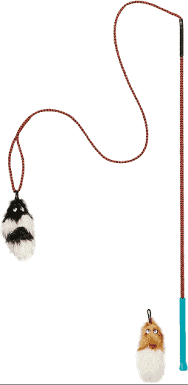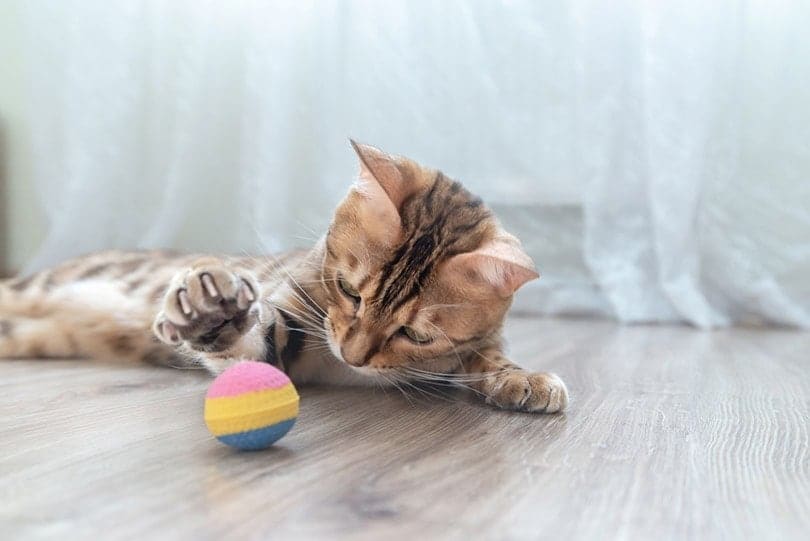
It can be hard to know what sort of toy to select for them, though. Some Bengal cats might love a twirling feather, while others will spend hours trying to get a ball out of a circuit. If you’re feeling overwhelmed by all the choices available, we’re here to help!
We enlisted a range of clever and discerning Bengal cats to help us review popular cat toys on the market today. We’ve narrowed the list down to the best toys for Bengal cats and can safely say that they all come highly recommended by our team of feline testers.
 A Quick Comparison of Our Winners in 2024
A Quick Comparison of Our Winners in 2024
| Image | Product | Details | ||
|---|---|---|---|---|
| Best Overall |
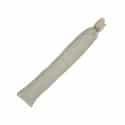
|
Hepper Catnip Stick Toy |
|
CHECK PRICE |
| Budget Buy |
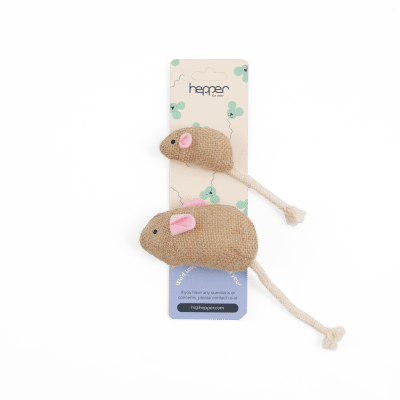
|
Hepper Mice Set Toy in Hessian |
|
CHECK PRICE |
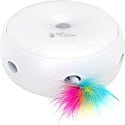
|
PetFusion Ambush Interactive |
|
CHECK PRICE | |
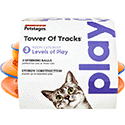
|
Petstages Tower of Tracks |
|
CHECK PRICE | |
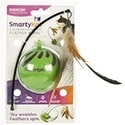
|
SmartyKat Feather Whirl |
|
CHECK PRICE |
The 11 Best Toys for Bengal Cats
1. Hepper Catnip Stick Toy — Best Overall
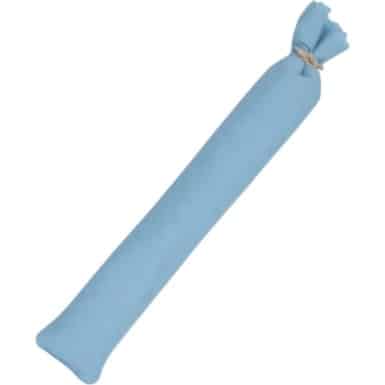
Hepper Catnip Stick Toy is our first place choice for best overall toys for Bengal Cats. Handmade in the USA, these catnip stix are made with 100% organic, high-quality catnip with no fillers. Cats have natural predatory behaviors, and with Hepper Catnip Sticks resembling prey, they can satisfy this behavior through healthy and stimulating playtime—making Hepper Catnip Stick toy the best toy for your Bengal Cat!
To give your Bengal Cat the stimulation and playtime it needs, Hepper Catnip Sticks are double-bagged and bite-proof, making them durable for hours of playtime. To further stimulate your Bengal Cat, these toys come in a variety of pastel colors to choose from! These are also very easy to clean with simple wiping, as needed.
At Catster, we’ve admired Hepper for many years, and decided to take a controlling ownership interest, so that we could benefit from the outstanding designs of this cool cat company!
- 100% organic catnip with no fillers
- Double-bagged and bite-proof for durability
- A variety of pastel-colored choices
- Keeps your cat physically and mentally stimulated
- Easy to clean
- Some cats don’t care for catnip
2. Hepper Hessian Mice Toy Set — Budget Buy
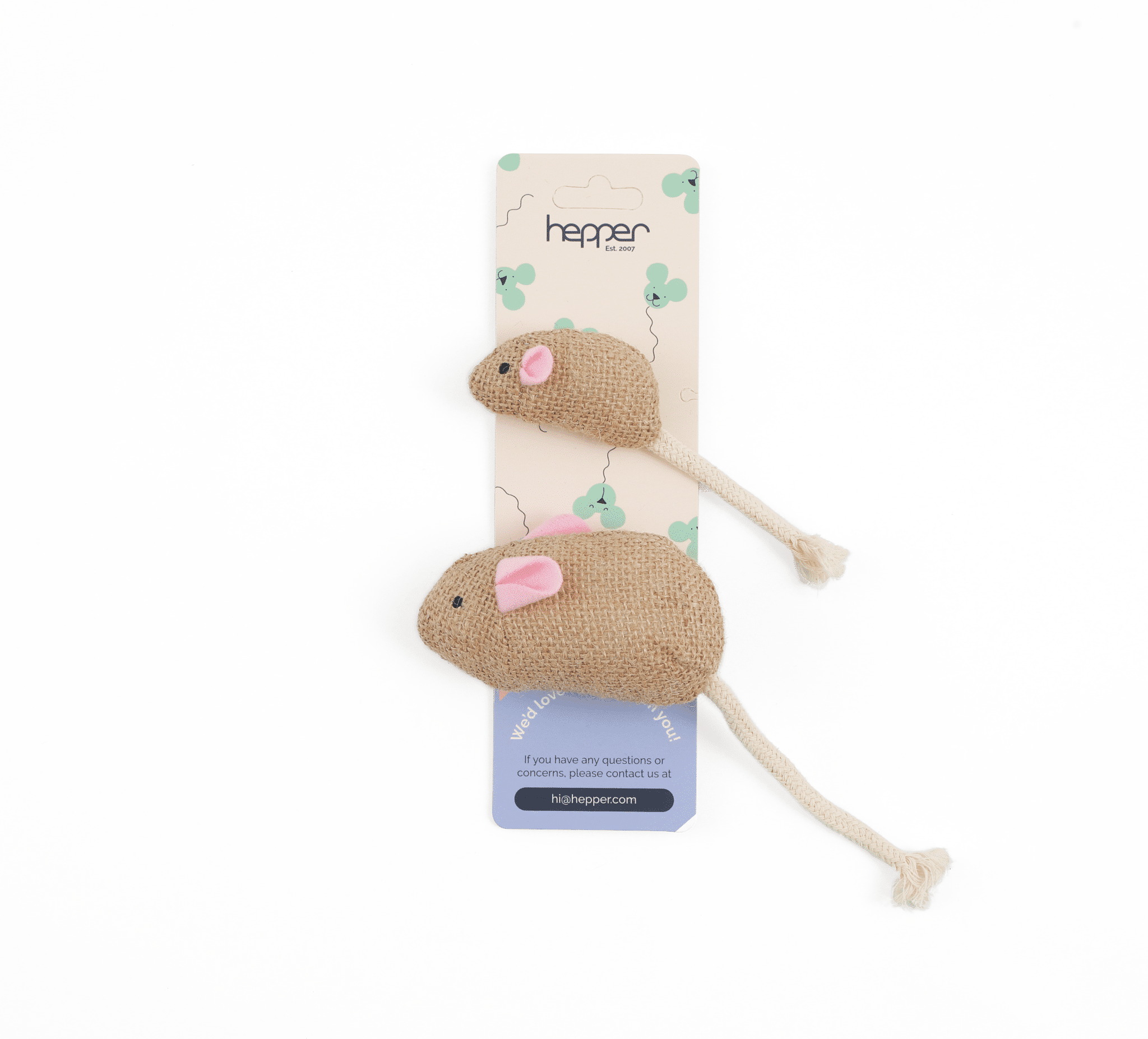
As the best budget toy for Bengal cats, the Hepper Hessian Mice Toy Set was an easy choice. Combining two classic toy features, catnip, and the mouse shape, your Bengal cat will find these little stuffed creatures highly entertaining. As an extra, the hessian, or burlap, fabric resembles that of real mice, something that’s sure to catch the hunter’s eye of your Bengal.
Once they catch them, they’re hit by the addictive scent of catnip, which is sure to make this toy a favorite. These set of mice comes in two sizes and are great for play sessions with your Bengal and promote self-regulated play when you’re not at home. As with any catnip toys, it’s best to put these away when not in use, to make sure the effect doesn’t wear off!
At Catster, we’ve admired Hepper for many years, and decided to take a controlling ownership interest, so that we could benefit from the outstanding designs of this cool cat company!
- Set of 2
- Contain catnip
- Lightweight
- Affordable
- Two sizes
- Great for interactive play or self-play
- Catnip scent will fade overtime
3. PetFusion Ambush Interactive Electronic Cat Toy
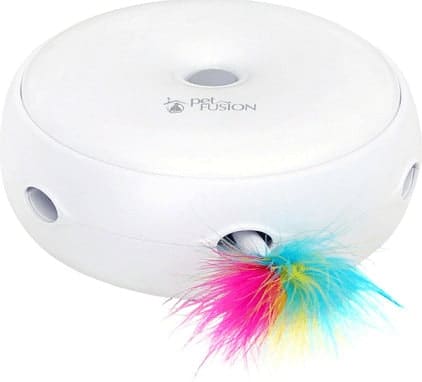
Bengal cats love to play at dawn and dusk, a time when many of us aren’t feeling our most awake! The PetFusion Ambush Interactive Electronic Cat Toy, is great for times like these. It’s packed full of features designed to make playtime fun, including a nighttime light, auto shut-off, and randomized activity designed to capture your Bengal’s interest.
The only reason that this cat toy didn’t make it into our top two is that it’s a little more expensive, so it might be something you wait to buy, though we’re sure their birthday is just around the corner! This is a great choice as a toy with which your Bengal can keep themselves entertained for hours.
- 12-month warranty
- Auto shut-off
- Batteries included
- Expensive
4. Petstages Tower of Tracks Cat Toy
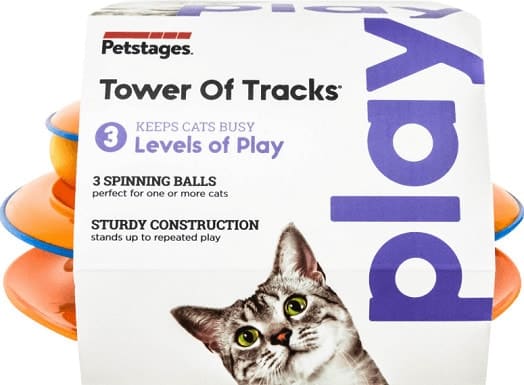
The Petstages Tower of Tracks Cat Toy has three levels, each with a different patterned ball designed to catch your cat’s attention. If you’ve got more than one cat, then this is the perfect solution, as the multiple levels mean they can play together without all fighting to get the same ball. The way the balls spin around each level is eye-catching for cats, meaning your Bengal may spend quite some time mesmerized by this toy.
One word of warning is that particularly determined cats can sometimes pry the balls out of the tracks. So, it’s worth giving this a daily check before the balls pop out and are lost forever.
- Good for independent play
- Suits multi-cat households
- Non-skid base
- Some cats can remove the balls
5. SmartyKat Feather Whirl Electronic Motion Cat Toy

Another great toy for Bengal cats is the SmartyKat Feather Whirl Electronic Motion Cat Toy. The rolling of the weighted ball base sets off an erratic whirling motion of the feather topper, sure to catch your cat’s interest! Bengal cats have a playful streak, so they’ll love the interactive nature of this toy, as it encourages them to play independently from their owners.
The quiet motor of this cat toy means you can switch it on and then go about your daily chores without being annoyed by an electronic whir. This toy provides a great way to provide an outlet for your Bengal cat’s never-ending reserves of energy!
- Quiet motor
- Long battery life
- Encourages independent play
- Not suitable for use on carpet
6. Bergan Turbo Scratcher Cat Toy
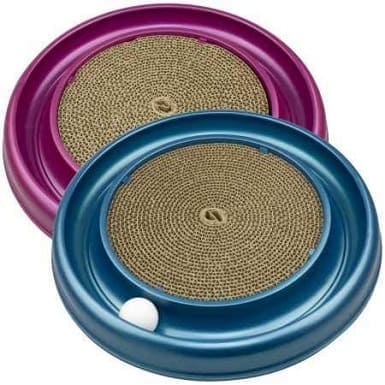
The Bergan Turbo Scratcher Cat Toy is well known for keeping many cats happily entertained for hours, and we include Bengals in that category! The spinning ball is contained within the outer channel, which allows your cat to indulge in their love of chasing and pouncing without running down hallways and knocking things over!
There’s also a core section made of a cardboard scratching pad, perfect for your Bengal to flex and stretch their muscles on after a fun game of chase. As if that’s not enough, this also includes a sachet of catnip that can be sprinkled over the center.
- Great value for money
- Replaceable central pad
- Hardwearing
- Can slide on hard floors
- The ball can be removed by some cats
7. Frisco Cat Tracks Butterfly Cat Toy
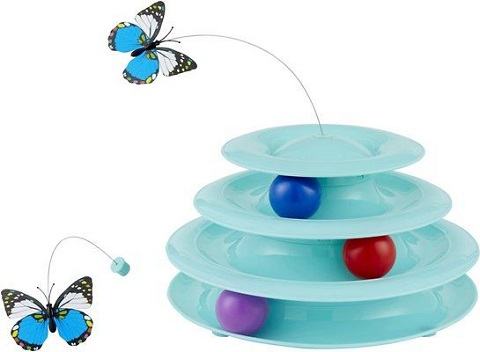
The Frisco Cat Tracks Butterfly Cat Toy combines two different types of toys to encourage your Bengal cat to spend plenty of time playing independently. The ball tower consists of three levels, each with a separate ball. This makes it great for multiple cats to enjoy together.
The butterfly attached to a flexible wand at the top of this toy will also catch their attention and encourage your Bengal cat to practice their pouncing skills. Be warned, though, that a strong cat (like a Bengal!) can knock this tower over, at which point, it is game over for the fluttering butterfly. Luckily, it comes with a replacement!
- Includes two butterflies
- Non-skid base
- Can be knocked over
- Not robust enough for some Bengal cats
8. SmartyKat Electronic Concealed Motion Cat Toy
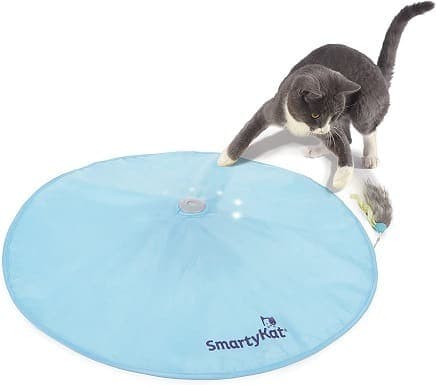
The SmartyKat Electronic Concealed Motion Cat Toy cleverly tricks your Bengal cat into thinking there’s a sneaky mouse caught under the surrounding fabric. As the toy spins around the fabric, the motion will attract any cat who sees it move. Then, of course, they’ll dedicate quite some time trying to catch whatever’s lurking under that cover!
The two speeds are great for adjusting how much energy you want your cat to burn, and this is a great way of encouraging your Bengal cat to play independently. One word of warning is that particularly keen Bengals can sometimes rip the fabric cover in their determination to uncover their prize!
- Two speeds
- Good for independent play
- The motor can be noisy
- Fabric is easily ripped
9. Hartz Just For Cats Peek & Play Pop-Up Tent Cat Toy
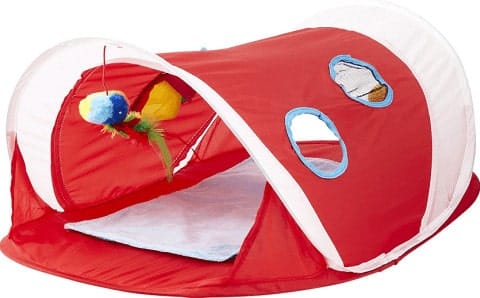
If your Bengal loves hiding behind doors and then pouncing on an unsuspecting human who happens to be walking past, you should probably treat them to the Hartz Just For Cats Peek & Play Pop-Up Tent Cat Toy. This tent is easy to assemble — in fact, it just pops right up and is ready for use straight away.
The multiple peepholes will provide your Bengal with plenty of opportunities for hiding, stalking, and pouncing, while the cute dangly toy will encourage their hunting instincts to the maximum. Unfortunately, the fabric on this is rather thin, so if your Bengal cat does get a bit too excited, then this can rip quite easily.
- Suitable for multiple cats
- One-step assembly
- Can get ripped
10. Catit Design Senses Circuit Cat Toy
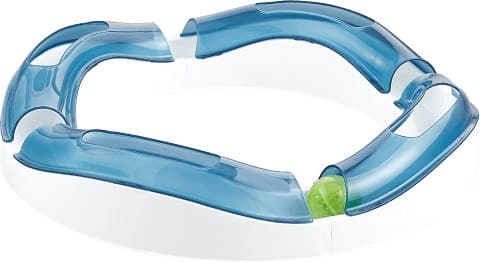
The Catit Design Senses Circuit Cat Toy is made of a series of interconnecting tubes that create an oval channel. The transparent top sections click into place, and two illuminated balls can then be placed into the channels. The lights on the balls caught the attention of our Bengal cat testers, but be warned that the batteries don’t last long. Once they’ve run out, there’s unfortunately no way to replace them, so you’ll have to pay for new balls or simply use a standard ball instead.
This is a good choice for multiple cats, as there’s space for cats to either sit outside or inside the track. Your cat will improve their paw-eye coordination by having to time their swatting for the balls in the uncovered sections of the track.
- Easy to assemble
- Tops can pop off
- Batteries don’t last for long
- Some cats can remove the ball
The Outward Hound Tail Teaser can be used to encourage your Bengal cat to chase and tug on a moving lure. This wand is designed for dogs, so it is robust enough to stand up to even the most determined Bengal cat. The robust handle is more hardwearing than some fishing rod style wands we’ve seen.
Unfortunately, the toy on the end isn’t quite so Bengal cat-proof, so you’ll need to keep a close eye on it if it’s getting worn. While it is not possible to buy replacements, we bet that you could attach a different brand of toy easily.
- Durable nylon cord
- Not suitable for independent play
- Replacement toys not available
- Toy not hardwearing
 Buyer’s Guide: Selecting the Best Toys for Bengal Cats
Buyer’s Guide: Selecting the Best Toys for Bengal Cats
When looking for the best toys to entertain your Bengal cat, certain versions just aren’t going to cut it. Bengal cats are strong and muscular, as well as fiercely intelligent. That means they can often become quickly bored with certain toys that might keep other cats entertained.
As a result, it can be hard to know what sort of toy to buy. But don’t worry! Our top 10 best Bengal cat toys suggestions combined with this buyer’s guide will give you all the information you need.
Types of toys for Bengal cats
It’s a good idea to provide your Bengal cat with a variety of toys designed to keep them occupied in different ways. You’ll want to make sure that you pick toys that encourage the following skills:
- Leaping and jumping: fishing rod-style toys and those attached to a string
- Chasing and running: laser pointers, electronic toys, and balls
- Pouncing, catching, and “killing”: kicker toys, catnip mice, and plush soft toys
- Coordination: treat balls, food puzzles, and ball runs
By giving your Bengal cat a range of toys that individually tick each of the categories above, you’re making sure they feel satisfied after a play session.
Interactive versus Independent
Bengal cats are well-known for their love of attention and their intelligence. While this is one of the reasons that makes them so loveable, it can also be a challenge to keep them occupied! A bored Bengal cat tends to start looking for trouble, so it’s a much better idea to provide them with a range of toys that you can use with them, as well as ones that you can leave out for them to use by themselves. These toys fall into two main categories: interactive and independent.
Interactive toys are those you’ll use to play with your Bengal cat actively. Examples include fishing rod-style toys, balls, soft plush toys, and anything that requires you to throw or dangle it. Playing with these types of toys is a great way to bond with your Bengal, but sometimes they’ll want to keep playing when you simply don’t have time.
This leads us to independent toys. These can be used by your Bengal on their own. Electronic pouncing toys, ball runs, and circuits are all examples of interactive toys. Some of these can be left on a timer, while others can be used by your cat simply by them batting a ball around a channel.
Final Thoughts
After spending time reviewing the best toys for Bengal cats available to buy this year, we selected the best overall as the Hepper Catnip Stick Toy. This self-play catnip kicker toy is a great way to keep any Bengal cat entertained.
Our second choice goes to the Hepper Hessian Mice Toy Set. These small toys might not look that interesting to us, but believe us when we say that they’ll drive your Bengal cat wild. The combination of the life-like hessian fabric, mouse shape, and catnip scent means this budget-friendly toy may well become a firm favorite.
While we love researching reviews like this, we couldn’t do it without our trusty team of feline testers. They’re always more than happy to let us know whether a particular toy gets their seal of approval, and we’re happy to report that all the toys in our favorites passed this particular inspection with flying colors! We hope they’ve helped you find the best Bengal cat toys for your kitty.
Feature Image Credit: Svetlana Rey, Shutterstock
Contents
- A Quick Comparison of Our Winners in 2024
- The 11 Best Toys for Bengal Cats
- 1. Hepper Catnip Stick Toy — Best Overall
- 2. Hepper Hessian Mice Toy Set — Budget Buy
- 3. PetFusion Ambush Interactive Electronic Cat Toy
- 4. Petstages Tower of Tracks Cat Toy
- 5. SmartyKat Feather Whirl Electronic Motion Cat Toy
- 6. Bergan Turbo Scratcher Cat Toy
- 7. Frisco Cat Tracks Butterfly Cat Toy
- 8. SmartyKat Electronic Concealed Motion Cat Toy
- 9. Hartz Just For Cats Peek & Play Pop-Up Tent Cat Toy
- 10. Catit Design Senses Circuit Cat Toy
- 11. Outward Hound Tail Teaser
- Buyer’s Guide: Selecting the Best Toys for Bengal Cats
- Final Thoughts


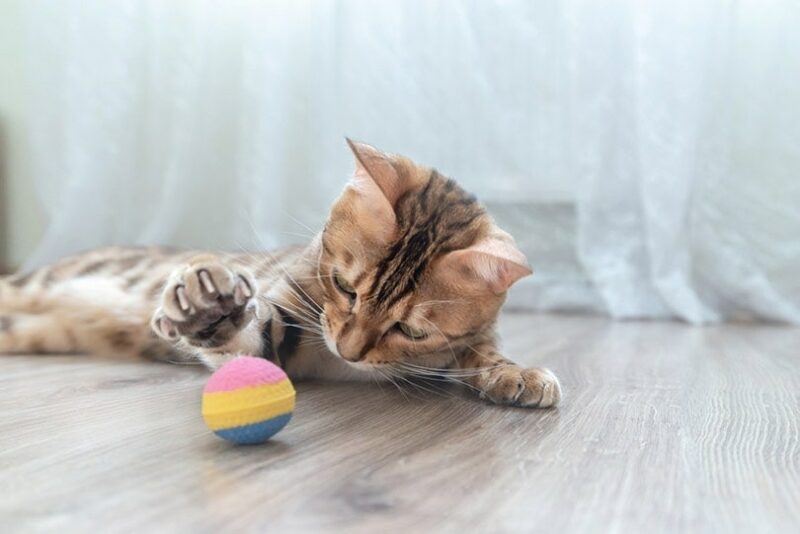
 A Quick Comparison of Our Winners in 2024
A Quick Comparison of Our Winners in 2024


